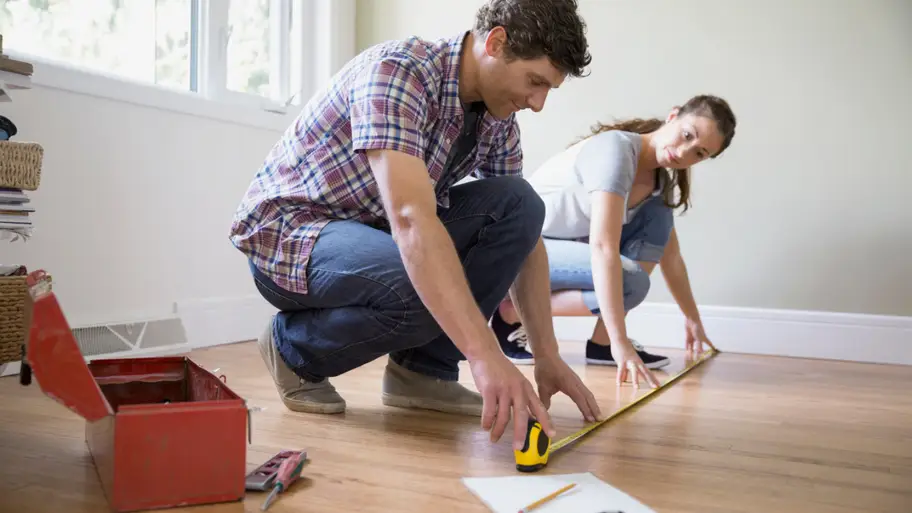How To Calculate The Square Footage Of A Home?

Estimating the square footage of a home is the first step in selling, buying, renovating, upgrading, etc. To calculate the square footage of a perfect rectangle, multiply its width by its height. However, a typical house is far more complex than a rectangle. So in this guide, we’ll find how to calculate square footage of a home in an easy way.
- What Is The Square Footage?
- Why Is Square Footage Important?
- What Is Considered A Home's Square Footage?
- What Is Not Included In A Home's Square Footage?
- How To Calculate The Square Footage Of A Home?
- How To Calculate Square Footage Of Different Types Of Rooms?
- The Bottom Line: How To Calculate Square Footage
- FAQ on How To Calculate Square Footage
What Is The Square Footage?
We already know the concept of the length and width of an object. Square footage or area is one step ahead in that direction. It guides us on how much flat surface an area contains. For example, we calculate the area of a rectangular room by multiplying the length by the width. The resultant value is a measure of the size of that room.
Now, we can plan any action about that room with this measurement. For instance, suppose you want to buy a carpet for a room. First, you need to know how much surface is there that you need to carpet. For example, if the length and width of the room are 10 feet each, then you need to cover 10x10 = 100 square feet. By knowing the total area, you can decide the carpet size. Now, if you have a rug of 5 feet in width and 10 feet in length, its square footage will be 5x10=50. So you know that you need two such carpets to cover the whole room. Similarly, you can use this value to decide which bed or furniture size will suit a specific room.
Square footage helps compare apples to apples. It also helps to evaluate the livability and price of a property. For example, according to Statista, the average square feet of a house in the U.S. has decreased since 2017. Similarly, realtor.com says the median square foot price in the U.S. is $123, but it can vary between $24-$810. Thus this terminology and its related data allow us to discuss the housing industry technically.
Why Is Square Footage Important?
The square footage or covered area of a house is important for many reasons. For example:
- It will measure the actual value of that property. The more usable a home's space, the more valuable it should be. It can also be a measure of the lifestyle of a family.
- The usability of the property also determines its price. If you want to buy or sell a house, its price will depend upon its covered area. So if two nearby homes are similar in other aspects, the house with the more usable space should cost more. Similarly, the rent amount of a house also depends upon its size.
- You can evaluate your upgrading options with this value. For example, if you want to buy new furniture or a carpet, you need to know the required space. The cost of renovation depends upon the square footage value. Even painters price their paint jobs based on the walls' size.
- The square footage of a house also determines the cost of maintaining that area. Thus buying the cooling or heating system for a property depends upon its size. An ample space not only needs a more expensive air conditioning system, but it will also have higher utility bills.
- Finally, the square footage of a house changes all calculations for taxation and mortgage purposes. For example, tax collectors base tax assessments on a home's usable space. If you feel your tax is higher, you can build your case by measuring the exact size. Similarly, while applying for a mortgage, the lender will need the square footage of a property for its calculations.
What Is Considered A Home's Square Footage?
While calculating the square footage of a home, the realtors only consider the liveable areas. These are the areas that meet two conditions. Firstly, one can walk easily to these areas. Secondly, one can live in that area for all four seasons of the year. So, for example, a lawn, though liveable sometimes, is not liveable in the rainy season or hot summer. Similarly, we can not walk into a space with a shallow roof.
We can consider any space with ceiling, flooring, proper walls, and air conditioning as a liveable area. All other spaces do not count in calculating the total size of a house. Finished places like kitchens, bathrooms, dining rooms, living rooms, and bedrooms are common liveable area calculation ingredients.
The concept of liveable space provides an excellent opportunity for sellers as it can increase home value. In fact, buying a house, improving its usable space, and selling it for a margin is a profitable business for many real estate professionals. So, if you are selling your home, there might be some areas you can upgrade to make them liveable. Indeed, this upgrade will increase the list price of your home. Consult with your realtor for any upgrade opportunities in your home.
What Is Not Included In A Home's Square Footage?
Places like unfinished basements, unheated rooms, porches, and attics usually do not meet the conditions of walkable or liveable. Thus, realtors typically do not include these areas while calculating the square footage of a home. Similarly, they ignore a garage, dog house, storage room, guest house, and pool house. However, depending upon their liveability, a realtor may or may not count a finished basement space in area calculations.
How To Calculate The Square Footage Of A Home?
Before finding the square footage of a home, you need some essential tools like a notepad, pen, calculator, and measuring device. You may use a laser measuring tool, but the usual measuring tape will do the task.
Calculating the area of a perfect rectangle is easy; however, not all areas of a house are pure rectangles. Use these tips to measure the square footage of complex floor plans.
- Get the original floor plan of the house. It may differ from the current floor plan, but it can be a good starting point. If it is unavailable, draw or sketch a rough floor plan. There is no need for perfection because you will be doing the measurement by tape. This sketch is only a helpful guide for calculating the square footage.
- Measure the length and width of all includable areas. Now multiply these length and width measurements to get the square footage of that room.
- Do the above steps for all rooms. Sum up the results. This result will be the total square footage of the home.
Other Methods To Calculate Square Footage
At times you may need to calculate square footage in other units. For example, inches, yards, and meters are other popular units to measure surface area. The general step for finding the square footage in another unit is to measure the length and width of the room in that unit. Thus if both are in yards, multiplying them will result in square yards. The same is true for meters and inches.
Describing an area in inches is useful for small items. To convert a square inch, multiply the length and width by 12 (12 inches in one foot) and then multiply the length and the width. For example, if the length and width are 10 feet each, it will be 120 (10x12) inches. Final square footage in inches will be 120x120 = 14400.
If you have both sides in feet, then you can use these handy math operations to find the area in other units:
- For converting square feet to square inches, multiply the area by 144.
- Getting square yards from square feet is possible by dividing the area by 9.
- For converting square feet to square meters, divide the measurement by 10.764.
If you need to convert square footage into other units, you can use google or an online conversion calculator to do these calculations easily.
How To Calculate Square Footage Of Different Types Of Rooms?
There are many types and shapes of spaces/rooms in a house. Therefore, we need to use different formulas for different kinds of shapes. Let us explore this.
Room With Special Areas
Some rooms may have particular areas like closets. For calculating the square footage of a room with cabinets, you need to consider them as two rectangles. Then calculate the size of each rectangle and add them together.
Circular Rooms
Circular rooms are rare because constructing a perfect circle in a building is challenging and has limitations. Also, a circular design may change the shapes of the surrounding rooms, if any. However, when there is a circular room, you can use the formula (22/7) x r x r, Where r is the circle's radius.
Rooms With Other Odd Shapes
If the room has no easy shape, you can divide it into simpler shapes. For example, you can split a room into rectangles, triangles, circles, etc. Then calculate the area of that shape and add them all together to know the total covered area of the house.
The Bottom Line: How To Calculate Square Footage
- Some experts believe summer is the best time to sell a house, while others may disagree. However, getting your home ready for selling will allow you to capture any good opportunity as soon as it arrives. Calculating the square footage of a house is a critical step in this regard.
- If you wonder what is the square footage of my house, then keep some points in mind. First, it is subjective, as not everyone follows the ANSI standard. Yet, any misrepresentation might lead to suing for damages, so you should take care in measuring this. Also, keep in mind your state's guidelines for area calculation. For example, a state may require mentioning the area in the listings, while other states may not require that.
- When in doubt, ask for professional help to avoid confusion. Professional appraisal fee for a single-family home is $300-$400. Two appraisers may announce slightly different estimates, but their approach is scientific, and the margin of difference is negligible. Also, they know the state laws better, so their estimations will be more acceptable.
FAQ on How To Calculate Square Footage
Here are common FAQs our customers ask us regularly.
